

Humans Sacrificed Brawn for Brains As We Evolved. Amongst all the evolutionary changes since hominids split from apes, the one we associate most closely with our humanness is probably our brains.

They’ve gotten larger and smarter as our cognition and society has gotten more complex. Neanderthals may have been our intellectual equals - life - 30 April 2014. Enough of the cheap jibes: Neanderthals may have been just as clever as modern humans.

Anthropologists have already demolished the idea that Neanderthals were dumb brutes, and now a review of the archaeological record suggests they were our equals. L'épanouissement personnel : une question de savoir être et de savoir penser ? Imaginer être altruiste rend altruiste ! Si vous imaginez que vous allez aider des personnes en détresse, vous aurez plus de chances de le faire effectivement !
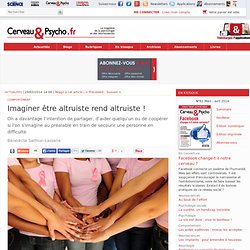
© Shutterstock / mangostock Pour en savoir plus L'auteur Bénédicte Salthun-Lassalle est rédactrice en chef adjointe à Cerveau & Psycho. « Ce n’est pas tant l’aide de nos amis qui nous aide que notre confiance dans cette aide. » Epicure ne s’y trompait pas : les êtres humains ont tendance à aider une personne dans le besoin et à savoir qu’on leur viendra en aide si nécessaire. Plusieurs études ont déjà montré que l’on est davantage susceptible de partager, d’aider quelqu'un et de coopérer si l'on a pris en compte la situation d'une personne dans le besoin ou si l’on a entendu un récit impliquant des individus qui ressentent des émotions. Stuff: Humans as hunters and mega-gatherers - life - 30 March 2014. How did we evolve from indigent apes with no possessions into hoarding humans with more stuff than we can track?

Our urge to accumulate has deep roots WHEN I moved house recently, I was overwhelmed by the number of boxes containing my family's possessions. It made me feel quite sick. Even so, I couldn't bring myself to throw any of it out. Possessions define us as a species; a life without them would be barely recognisable as human. Inclusive fitness theory for the evolution of religion. Special issue: Kin Selection a Department of Biological Sciences, Simon Fraser University, Burnaby, BC, Canadab Department of Biology, East Carolina University, Greenville, NC, U.S.A.
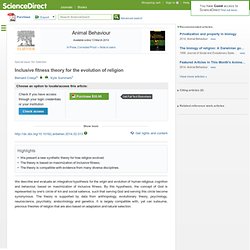
Received 11 October 2013, Revised 14 January 2014, Accepted 6 February 2014, Available online 13 March 2014 MS. number: ASI-13-00853 Choose an option to locate/access this article: Assortative mating based on cooperativeness and generosity - Tognetti - 2014 - Journal of Evolutionary Biology. Our blender brain: How mixing ideas made us human - opinion - 26 February 2014. THERE are many things that humans can't do.

We can't run like cheetahs, fly like eagles or echolocate insects like bats. But the human contribution to the miracle of life is obvious: we are the origin of new ideas. We hit upon new ideas, lots of them, on the fly, all the time. They arise constantly in our minds, and sometimes tumble out to influence other minds and change the world. Comment le cerveau fabrique la religion.
Pour en savoir plus.
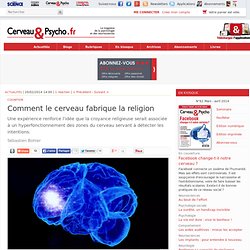
The Blue Sapphire of the Mind: Notes for a Contemplative Ecology: Amazon.fr: Douglas E. Christie: Livres anglais et étrangers. Des gènes néandertaliens inégalement répartis. Sriram Sankararaman et ses collègues de l’École médicale de Harvard et de l’Institut pour l’anthropologie évolutive de Leipzig, viennent de conduire une étude systématique des traces d’ADN néandertalien chez 1 004 individus actuels.
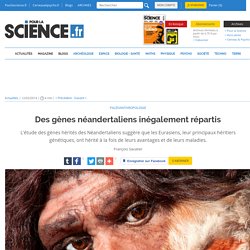
Les résultats confirment que les Eurasiens ont dans leur génome entre deux et quatre pour cent de gènes néandertaliens, tandis que la proportion est beaucoup plus faible dans d'autres populations. Les apports néandertaliens sont nombreux pour plusieurs gènes importants sur le plan fonctionnel. Ils auraient favorisé l'adaptation de nos ancêtres Homo sapiens à l’environnement eurasien. Cependant, ils seraient également responsables de certaines maladies.
The Quarterly Review of Biology, Vol. 89, No. 1 (March 2014), p. 55. The Quarterly Review of Biology, Vol. 89, No. 1 (March 2014), pp. 58-59. Humanity's forgotten return to Africa revealed in DNA - life - 03 February 2014. Not so isolated: Khoisan tribes have European DNA (Image: Ariadne Van Zandbergen/Alamy) Call it humanity's unexpected U-turn.
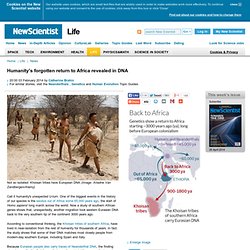
One of the biggest events in the history of our species is the exodus out of Africa some 65,000 years ago, the start of Homo sapiens' long march across the world. Now a study of southern African genes shows that, unexpectedly, another migration took western Eurasian DNA back to the very southern tip of the continent 3000 years ago. Humanity's forgotten return to Africa revealed in DNA - life - 03 February 2014. Not so isolated: Khoisan tribes have European DNA (Image: Ariadne Van Zandbergen/Alamy) Call it humanity's unexpected U-turn.
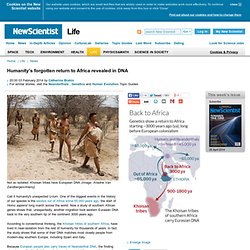
One of the biggest events in the history of our species is the exodus out of Africa some 65,000 years ago, the start of Homo sapiens' long march across the world. Now a study of southern African genes shows that, unexpectedly, another migration took western Eurasian DNA back to the very southern tip of the continent 3000 years ago. What separates us from other animals? - life - 27 January 2014. Read full article Continue reading page |1|2 Book information The Gap: The science of what separates us from other animals by Thomas Suddendorf Published by: Basic Books Price: $29.99 For all that separates us from gorillas and other great apes, we are family (Image: Bruce Davidson/naturepl.com) We are unlike any other animal, but the differences are surprisingly difficult to pin down.
The Gap by Thomas Suddendorf is the most comprehensive attempt yet "THIS book is about you," goes the beguiling first sentence of The Gap. There is indeed something vain about we navel-gazing humans, arrogantly pondering our specialness even as we destroy the environment and with it the species that are purportedly inferior to us. The book begins by setting up an intriguing premise. The urge to dehumanise others is itself all too human - opinion - 22 January 2014. Recognising dehumanisation as part of human nature helps us guard against its darkest consequences IT IS a depressingly familiar story. Two communities live in cheek-by-jowl harmony until, one day, they don't. Then, for reasons that may on the face of it seem quite trivial – a property dispute, or a social slight, perhaps – a rift develops.
Long-lost lake may have helped humans out of Africa - life - 17 January 2014. A giant, long-vanished lake along the White Nile may have been a vital way station for early modern humans leaving Africa. Archaeologists say the 45,000-square-kilometre lake, which would be one of the ten largest lakes on Earth if it existed today, was in the right place at the right time for at least one of two key migrations.
One exodus took people to what is now Israel before 100,000 years ago, and another peopled Eurasia 70,000 years ago. A Missing Genetic Link in Human Evolution. From Quanta Magazine (find original story here). About 8 million to 12 million years ago, the ancestor of great apes, including humans, underwent a dramatic genetic change. Small pieces of DNA replicated and spread across their resident chromosomes like dandelions across a lawn.
But as these “dandelion seeds” dispersed, they carried some grass and daisy seeds — additional segments of DNA — along for the ride. This unusual pattern, repeated in different parts of the genome, is found only in great apes — bonobos, chimpanzees, gorillas and humans. “I think it’s a missing piece of human evolution,” said Evan Eichler, a geneticist at the University of Washington, in Seattle. Over the past few years, scientists have begun to uncover the function of a handful of genes that reside in these regions; they seem to play an important role in the brain, linked to the growth of new cells, as well as brain size and development. A Missing Genetic Link in Human Evolution. About 8 million to 12 million years ago, the ancestor of great apes, including humans, underwent a dramatic genetic change.
Small pieces of DNA replicated and spread across their resident chromosomes like dandelions across a lawn. But as these “dandelion seeds” dispersed, they carried some grass and daisy seeds — additional segments of DNA — along for the ride. This unusual pattern, repeated in different parts of the genome, is found only in great apes — bonobos, chimpanzees, gorillas and humans. Cultural transmission and the evolution of human behaviour: a general approach based on the Price equation - El Mouden - 2013 - Journal of Evolutionary Biology. Taille d'un groupe humain et complexité culturelle. Workouts are no antidote to death by desk job - health - 04 July 2013. Editorial: "Don't take life sitting down" MICHAEL JENSEN is talking to me on the phone, but his voice is drowned out by what sounds like a vacuum cleaner. Or maybe it's a lawnmower. I'm used to bad connections, but Jensen isn't using Bluetooth on a busy freeway.
Where Do Nonhuman Mammals Fit in Our Moral Hierarchy? The case for exploiting animals for food, clothing and entertainment often relies on our superior intelligence, language and self-awareness: the rights of the superior being trump those of the inferior. A poignant counterargument is Mark Devries's Speciesism: The Movie, which I saw at the premiere in September 2013. The animal advocates who filled the Los Angeles theater cheered wildly for Princeton University ethicist Peter Singer. In the film, Singer and Devries argue that some animals have the mental upper hand over certain humans, such as infants, people in comas, and the severely mentally handicapped.
How unique is the human neocortex? + Author Affiliations ↵* Author for correspondence (zoltan.molnar@dpag.ox.ac.uk) The human cerebral cortex is generally considered the most complex organ, and is the structure that we hold responsible for the repertoire of behavior that distinguishes us from our closest living and extinct relatives. Creativity, Madness and Drugs. Human Health Depends on a Healthy Environment: Scientific American Podcast. Dormir permet au cerveau de se nettoyer.
Humans and Nature: How Knowing and Experiencing Nature Affect Well-Being - Annual Review of Environment and Resources, 38(1):473. Naturecultures? Science, Affect and the Non-human. Mara Miele Joanna Latimer, Cardiff University, Glamorgan Building, King Edward VII Avenue, Cardiff CF10 3WT, UK. A New Frontier in Animal Intelligence. Santino was a misanthrope with a habit of pelting tourists with rocks. As his reputation for mischief grew, he had to devise increasingly clever ways to ambush his wary victims. Having the stomach for it: a contribution to Neanderthal diets? Abstract Due to the central position of diet in determining ecology and behaviour, much research has been devoted to uncovering Neanderthal subsistence strategies. Environmental crisis as the final stage of the evolution of culture. PsycNET - Display Record. Manners maketh man: how disgust shaped human evolution - life - 24 September 2013.
YOU wake up in the morning. Your partner burps and drags on a smelly dressing gown. You can't find your toothbrush so you use his, and then wipe some muck off the floor with it. Leaving the house, you step over a turd deposited by a neighbour, then drive into a traffic jam caused by everyone ignoring the lights. La cruauté est-elle universelle ? How to Exploit the Power of Diverse Minds.
Language as tool: The analogy to primate cognition. We have been "consumed" for ~100,000 years - Gene Expression. Altruism Can Be Contagious. One Person is No Person. Human cumulative culture: a comparative perspective - Dean - 2013 - Biological Reviews. Challenging Transhumanism's Values - Green - 2013 - Hastings Center Report. Humans and other animals. Biosocial Becomings: Integrating Social and Biological Anthropology.